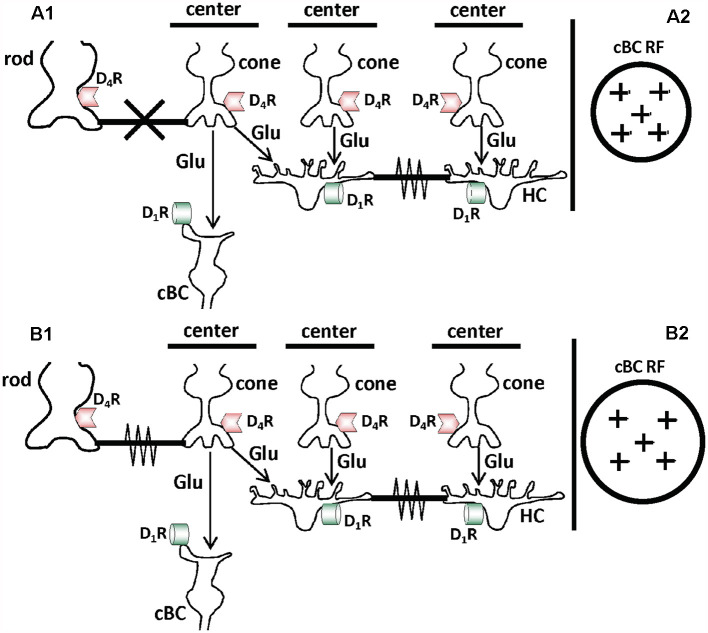Figure 8.
Schematic diagrams showing that the retinal circadian clock, by regulating activation of D4 receptors on cones and rods, controls electrical synaptic signaling between rods and cones and the receptive field size of cones. (A1,B1) Cell types, transmitter receptors, and gap junctions are the same as in Figure 1, but the retinal clock regulates their expression and function in day and night differently compared to the effects of background illumination. The different effects of the retinal clock and background illumination occur because the circadian clock and light activate D4Rs and D1Rs, respectively (Figure 2). Although the retinal clock releases less dopamine in the day than bright light, circadian clock-induced dopamine release in the day is sufficient to activate cone D4Rs (but not D1Rs; Figure 2). This is because D4Rs are ~500 times more sensitive to dopamine than D1Rs. In constant darkness at night, dopamine levels are lower than in the day and not sufficient to activate cone D4Rs. The retinal clock, therefore, controls D4R-mediated phenomena such as rod-cone coupling but not D1R-mediated effects such as GABAAR expression and function on cBC dendrites and gap junction coupling between HCs. As a result, in maintained darkness in both day and night when D1Rs are not activated, cBC dendrites lack GABAARs, HC gap junctions are open, and cBCs lack receptive field surrounds. (A1,A2) Following maintained darkness in the day, the retinal clock releases sufficient dopamine to activate D4Rs in cones and rods, which decreases cAMP/PKA in the cells. As a result, gap junctions between rods and cones are closed (A1). The RF center of cBCs is large because they lack RF surrounds due to the lack of GABAARs on its dendrites. However, the RF center of cBCs may not be as large as at night (A2). (B1,B2) Following maintained darkness at night, the retinal clock does not release enough dopamine to activate D4Rs in cones and rods, which increases cAMP/PKA in the cells. As a result, gap junctions between rods and cones are open (B1). Evidence indicates that the RFs of cones are larger at night in the dark than in the day in the dark due to increased photoreceptor coupling. It is hypothesized that the RF center of cBCs is therefore larger at night in the dark than in the day (B2).

